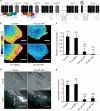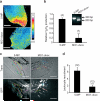A tissue-scale gradient of hydrogen peroxide mediates rapid wound detection in zebrafish
- PMID: 19494811
- PMCID: PMC2803098
- DOI: 10.1038/nature08119
A tissue-scale gradient of hydrogen peroxide mediates rapid wound detection in zebrafish
Abstract
Barrier structures (for example, epithelia around tissues and plasma membranes around cells) are required for internal homeostasis and protection from pathogens. Wound detection and healing represent a dormant morphogenetic program that can be rapidly executed to restore barrier integrity and tissue homeostasis. In animals, initial steps include recruitment of leukocytes to the site of injury across distances of hundreds of micrometres within minutes of wounding. The spatial signals that direct this immediate tissue response are unknown. Owing to their fast diffusion and versatile biological activities, reactive oxygen species, including hydrogen peroxide (H(2)O(2)), are interesting candidates for wound-to-leukocyte signalling. Here we probe the role of H(2)O(2) during the early events of wound responses in zebrafish larvae expressing a genetically encoded H(2)O(2) sensor. This reporter revealed a sustained rise in H(2)O(2) concentration at the wound margin, starting approximately 3 min after wounding and peaking at approximately 20 min, which extended approximately 100-200 microm into the tail-fin epithelium as a decreasing concentration gradient. Using pharmacological and genetic inhibition, we show that this gradient is created by dual oxidase (Duox), and that it is required for rapid recruitment of leukocytes to the wound. This is the first observation, to our knowledge, of a tissue-scale H(2)O(2) pattern, and the first evidence that H(2)O(2) signals to leukocytes in tissues, in addition to its known antiseptic role.
Figures



Comment in
-
Inflammation: Wound healing in zebrafish.Nature. 2009 Jun 18;459(7249):921-3. doi: 10.1038/459921a. Nature. 2009. PMID: 19536251 No abstract available.
References
-
- Nusslein-Volhard C, Dahm R. Zebrafish. Oxford University Press; NY: 2002.
-
- Belousov VV, et al. Genetically encoded fluorescent indicator for intracellular hydrogen peroxide. Nat Methods. 2006;3:281–6. - PubMed
-
- Bienert GP, Schjoerring JK, Jahn TP. Membrane transport of hydrogen peroxide. Biochim Biophys Acta. 2006;1758:994–1003. - PubMed
Publication types
MeSH terms
Substances
Grants and funding
LinkOut - more resources
Full Text Sources
Other Literature Sources
Medical
Molecular Biology Databases

